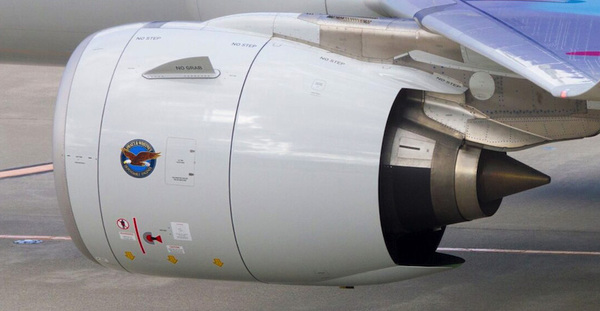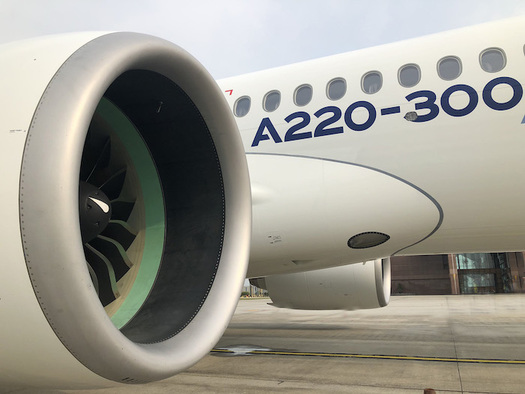An automatic start on ground is aborted by the Electronic Engine Control (EEC) when one of the conditions that follow occurs: N1 locked rotor, Hot or hung start, Loss of Exhaust Gas Temperature (EGT) data, Igniter failure, or Fuel control failure. Before a restart on the ground, the automatic start allows an engine motoring period of 30 seconds to clear fuel vapors and cool the engine components. The EEC then performs a single restart attempt when N2 is below _____.
During high power ground runs (more than 60% N1), maintenance runs must be done with aircraft headed into wind.
Before engine start, the flight crew shall confirm that the thrust lever is set to idle. The engine will start regardless of the position of the thrust lever and thrust level will quickly increase to the thrust lever setting, which can cause a hazardous situation.
After three start attempts, or after four minutes continuous cranking, a _____ cooling period is required.
Thrust reverser system - When deployed, the synchronized electric actuators move the translating sleeves aft, which causes the blocker doors to rotate.
The actuators are hydraulically operated.
Each Electronic Engine Control (EEC) channel controls one igniter. During the first automatic start attempt on-ground, the Full Authority Digital Engine Control (FADEC) _____.
In subsequent automatic start attempts, the FADEC will alternate the igniter used in order to prolong ignitor life. During manual start attempts on-ground, the CONT IGNITION switch is selected to ON. During manual or automatic start attempts or in-flight, the EEC activates both igniters.
Each engine has one electrically-independent ignition system. The exciter box converts low voltage into high voltage to ignite the fuel/air mixture in the combustor.
Each engine has two electrically-independent ignition systems. The ignition system receives power from the DC ESS busses, and is available during engine start, engine relight, or when environmental conditions require continuous ignition.
The reverse idle supports ground operation with the thrust reversers deployed. It is available with the thrust levers in the REV IDLE position. When REV IDLE is automatically commanded, the landing maximum reverse thrust setting supports the landing maneuver from Thrust Reversers deployment down to a speed of _____.
Engine start is prohibited:
N1 synchronization indication - The N1 synchronization is an automatic function controlled by the EEC. It synchronizes the speed of the engines to minimize harmonic noise in the aircraft. The function uses:
The synchronization is accomplished by fuel trimming on the slave engine.
Advertisement
When the airplane is cold-soaked at an ambient temperature of _____ or below for more than 8 hours, the thrust reversers must be cycled a minimum of 2 times before takeoff on wet or contaminated runway.
The Electronic Engine Control (EEC) is powered by the Permanent Magnet Alternator/Generator (PMAG), which is driven by the Main Gearbox (MGB). N2 has to be greater than _____ to ensure adequate electrical power for the EEC.
The EEC is the core of the FADEC. It is a dual-channel unit installed on the left side of the fan case. One channel of the EEC is capable of complete system control and the other one is a backup if there is a failure
The N2 speed indications are provided by a dual-channel probe powered by the Permanent Magnet Alternator/Generator (PMAG).
The sensor signal is sent to the EEC, which processes it and displays it on the EICAS page in digital format (%). The EEC also uses the N2 data for starting, overspeed monitoring, shaft shear detection, and for other functions.
During start, the Electronic Engine Control (EEC) commands the Starter Air Valve (SAV) to supply pneumatic pressure to the Air Turbine Starter (ATS), which cranks the engine. ATS speed is monitored by the EEC, which disengages the ATS at approximately _____ N2.
The automatic start gives the Electronic Engine Control (EEC) full control of the start sequence, depending on whether the aircraft is on the ground or in flight. For in-flight starts, the starter assist is automatically commanded by the EEC _____, where windmilling airflow into the engine is insufficient for engine starting.
During a manual start, the flight crew controls the start sequence and the Electronic Engine Control (EEC) has limited control. The EEC continues to provide start and fault indications on the Engine Indication and Crew Alerting System (EICAS) page but the automatic abort feature is disabled and pilot monitoring of the start parameters is required.
The Thrust Control Malfunction (TCM) protection, incorporated in the FADEC, provides protection against Uncontrolled High Thrust (UHT) events. A UHT event is defined as the inability to reduce thrust. When a UHT event is detected the Thrust Control Malfunction Accommodation (TCMA) shuts down the affected engine.
When a UHT event is detected on the ground while reverse thrust is not applied, the Thrust Control Malfunction Accommodation (TCMA) shuts down the affected engine. In-flight or during reverser operation, the TCM protection posts the L(R) THROTTLE FAIL caution message on the EICAS page and the TCMA is delayed until ground confirmation or completion of reverse.
When starting an engine on ground, the maximum tailwind component is:
The vibrations of N1, N2, and the fan are measured by sensors (accelerometers). These sensors send vibration data to the Prognostics and Health Management Unit (PHMU) and to the EEC for display on the EICAS page. When the N1 or N2 vibration approaches the limit, the caution message ENG VIBRATION is displayed on the EICAS page with an amber VIB flag on the affected engine N1 or N2 engine indication.
When the N1 or N2 vibration exceeds the limit, the caution message ENG VIBRATION is displayed on the EICAS page with an amber VIB flag on the affected engine N1 or N2 engine indication.
The continuous ignition system is activated automatically by the FADEC during takeoff and landing phase, based on radio-altimeter inputs or airspeed inputs.

The continuous ignition system is activated automatically by the FADEC during takeoff and landing phase: it is based on the Flight Management System (FMS) information.
Advertisement
N1 synchronization indication - The N1 synchronization is an automatic function controlled by the EEC. It synchronizes the speed of the engines to minimize harmonic noise in the aircraft. What is the true statement?
Thrust reverser system - During deployment, the baulk mechanism blocks the thrust levers in the idle position until thrust reverser deployment is confirmed. After deployment, the mechanism allows the thrust levers to enter in the reverse thrust range.
The approach idle is designed to reduce spool-up time from idle to go-around thrust. It is set in-flight when the aircraft enters the _____, when flap 4 is selected (to configure for a flap 4 landing), or when the landing gear is down.
Approach idle thrust is higher than minimum idle, and enables more rapid engine acceleration from idle to Go-Around (GA) thrust.
When starting an engine on ground, the maximum crosswind component is:

